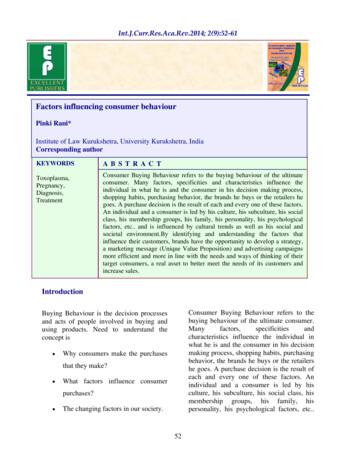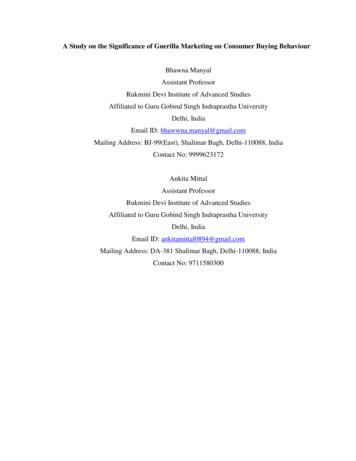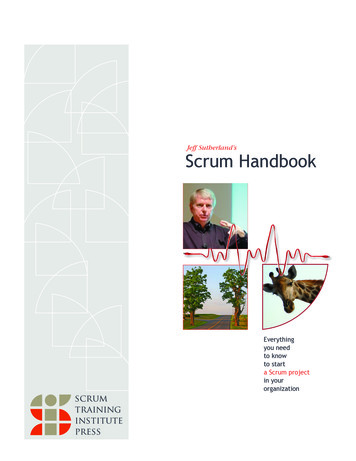FACTORS INFLUENCING CONSUMER BUYING BEHAVIOUR: A REVIEW
FACTORS INFLUENCING CONSUMER BUYING BEHAVIOUR:A REVIEWSYED AZHER ALIResearch ScholarSwami Ramanand Teerth Marathwada University,Nanded (MS) INDIAConsumer buying behavior is the behavior of final consumer. The consumer buying decisionprocess is influenced by many internal and external factors. A purchase decision is theoutcome of all these factors. The present paper focuses on major factors influencingconsumer buying behavior. . The study included secondary data collected from differentsources such as journals, books, magazines etc. The study gives a comprehensiveunderstanding of influence of cultural, social, personal and psychological factors on buyingbehavior.Key Words: Consumer buying behavior, cultural, social, personal and psychological factors.INTRODUCTIONScholars define buyer behavior as the buying behavior of final consumers. They may beindividuals and households. They buy goods and services for personal consumption. Theorganizational buyers differ from consumers in the way that they resell goods and services.Marketing stimuli like Product, Price, Place and Promotion affect buyers’ behavior.OBJECTIVE OF THE STUDY:The primary objective of the study is to understand factors influencing consumer buyingbehavior,. It aims at investigating cultural, social, personal and psychological factorsinfluencing buying behavior.RESEARCH METHODOLOGY:The research is descriptive in nature. The data have been collected through secondary sourcessuch as journals, magazines, books, theses, market research reports etc.Literature Review:SYED AZHER ALI1 P age
The four most important factors affecting buyers’ behavior are: Cultural Factors, SocialFactors, Personal Factors and Psychological Factors. Scholars have discussed these factors indifferent pairs and groups. Fatimah Furaiji, et. al. (2012) enlists the studies as in thefollowing.Table 2.1: Factors Affecting Buying BehaviourResearcherMajor factorsEnis (1974)personal and social factorsCross and Peterson (1987)social and physical factorsDibb and Etal (1991)Personal, social and physical factorsCohen (1991)marketing mix, physical factorsZikmond and Amico (1993)social, environmental and individual factorsMcCarthy and Perreault (1993)physical and social factorsNarayyana and Raol (1993)Physical, social and cultural factorsKeegan (1995)social, cultural, economic and geographic factorsSetlow (1996)personal factors, marketing mix and environmentalfactorsStanton (1997)social, physical and attitudinal factorsLancaster and Reynold (1998)physical, social and cultural factorsStraughan and Roberts (1999)demographic factors and lifestylePride and Ferrell (2000)social, physical and attitudinal factorsKotler and Armstrong (2007)Physical, social, cultural and personal factorsSYED AZHER ALI2 P age
The researchers like Kotler, Meyer and Eagle, Zeithaml, Davies have also contributed a lot tothe area of buying behaviour. Following are the most commonly accepted factors influencingbuying behaviour.Fig 2.2: Factors Affecting Buying Behaviour2.3.1 Cultural Factors:Cultural factors play a significant role in influencing buying behaviour. These includeculture, Sub-culture and social class. Hofstede (1980) defined culture as collectiveprogramming of the mind that distinguishes the members of one group or category froanother. Culture is regarded as the complex whole that includes, knowledge, belief, customstraditions, morals and habits acquired by humans as a society. It decides how consumersthink and feel. According to Hawkins et. al. (2001), it influences attitude, values, personalitytype, religion and material possession. According to Hofstede (2002) culture has fivedimensions. These are as follows.A culture may have many subcultures. It is a small segment of a culture and it has the samemeaning and values of a culture. Subcultures transfer these values, belief, attitude etc. fromone generation to other. Burgess (1998) stated that religion, race and ethnic backgrounddecides the way of dressing, food, furnishing and personal care.Social classes are defined as groups more or less homogeneous and ranked against each otheraccording to a form of social hierarchy. Social class is defined by the person’s income andSYED AZHER ALI3 P age
the amount of money one possesses decides his social class. Another dimension to socialclass is of the residential area. According to some scholars the place of living decides one’ssocial class.2.3.2 Social Factors:Social factors include reference group, family, roles and status. According to Kotler et. al.(2008), reference groups have a direct and indirect influence upon a person‘s attitudes,aspirations or behaviour. These include inspirational groups, member groups and opinionleaders. These generally provide points of comparison with respect to lifestyle, desires andhabits. As identified by researchers, reference groups play several roles. These include theinitiator, influencer, decision maker and buyer. According to Hawkins et. al. (2001)reference groups can take three influential forms i.e. normative, informational andidentification.Family is considered to be the most influential social factor. It is defined as a group of peoplerelated by blood, marriage and adoption that reside together. This group is of two or morepeople. Engel et. al. (1995) studied the importance of household and families for themarketers. According to them household are becoming a more important area of studybecause of growth of non-traditional families.Roles and status of individuals is also a vital constituent of social influence. The position ofan individual within the family, work place, social clubs and his friend circle decides his roleand status. This is affected by his profession, position at work place, education, position inthe family and gender.2.3.3 Personal Factors:Personal factors include age, stage of life cycle, occupation, economic condition, lifestyle,personality and self concept. These are the fundamental factors contributing to the change inpreferences.Age and life cycle has a great impact on buying behaviour. The behaviour of a child,teenager, adult, middle aged and a senior citizen is bound to differ. The preferences ofindividuals change with the passage of time. Family stages and life cycle include phase likeyoung, single, married couple, parenting, empty nest (launching adult children) and seniorstage of life.Occupation is assumed to have a significant impact on buying behaviour. The individualsshow a great inclination towards products and services according to their profession.SYED AZHER ALI4 P age
Economic condition is the totality of one’s earnings and income. The economic conditionmay change according to the changing income and spending patterns. The potentialconsumers are the consumers with an ability and willingness to pay. A consumer is willing topay more only if he has high income and savings. Other variables like inflation, deflation,recession etc. have a direct impact on one’s economic condition.Lifestyle is a set of activities, interests and opinions. It changes with the changing personalfactors like age, income, life cycle and occupation. Johanna Fyrbjörk (2003) cited that thepeople coming from the same social background or sub-culture, social group, and even theprofession may have quite different life styles. The researchers have identified eightdimensions of lifestyle. These are fashion consciousness, leadership, family concerns, healthconsciousness, care freeness, community consciousness, cost consciousness and practicality.Personality and self concept is another important personal factor. Personality refers to theunique psychological characteristics leading to relatively consistent and lasting responses toone‘s own environment.2.3.4 Psychological Factors:Psychological factors affecting various purchase decisions include motivation, perception,learning, beliefs and attitudes. Lantos GP. (2011) concluded motivation as an activatedinternal need state that leads to goal-directed behaviour so as to satisfy that need.Accordingly motives can be defined as relatively enduring, strong, and persistent internalstimuli that arouse and direct behaviour toward certain goals to achieve certain objectives.Perception is the energy which makes us aware of the world around us and attaches ameaning to it after a sensing process. Every person sees his or her surrounding in differentmanner. Several people have the same opinion and thoughts about a particular event. No onecan see or feel the 100% of all things.Learning is a change in a person‘s thought processes caused by prior experience. Accordingto William D. Perreault and E. Jerome McCarthy (2002), consumer learning may resultfrom things that marketers do, or it may result from stimuli that have nothing to do withmarketing. Either way, almost all consumer behaviour is learned.Kotler (1994) defines belief as a descriptive thought that a person holds about something. Healso defined attitude as a person‘s abiding favorable or unfavorable cognitive evaluations,emotional feelings, and action tendencies toward some object or idea.SYED AZHER ALI5 P age
CONCLUSION:Today everything revolves around the customer hence the study of buying behaviourbecomes a necessity. The customers have great options to select in the modern marketing.Hence, persuasion of the customers by the marketers has a great impact on their buyingbehaviour. In order to persuade the consumers, the marketers have to study the consumerbehaviour. So, influence of cultural, social, personal and psychological factors on buyingbehavior will give marketers a clear understanding of behaviour patterns.1. Fatimah Furaij , Małgorzata Łatuszyńska , Agata Wawrzyniak, (2012). “An EmpiricalStudy of the Factors influencing Consumer Behaviour in the Electric AppliancesMarket”, Contemporary Economics, Vol. 6 Issue3, p.76-862. Hawkins, D. I., & Mothersbaugh, D. L. (2007). Consumer behavior: Buildingmarketing strategy, McGraw-Hill Education (India) Pvt Limited3. Johanna Fyrbjörk (2003), “ Attitides and Consumer Behaviour”, Bachelor Thesis4. Pinki, Rani (2014). “Factors influencing consumer behavior”, International Journal ofCurrent Research and Academic Review, Vol. 2, Issue 9, 52-615. Philip Kotler & Gary Armstrong (2007). Principles of Marketing. Prentice Hall ofIndia Private Limited New Delhi.SYED AZHER ALI6 P age
The present paper focuses on major factors influencing consumer buying behavior. . The study included secondary data collected from different sources such as journals, books, magazines etc. The study gives a comprehensive understanding of influence of cultural, social, personal and psychological factors on buying behavior.
customers , to study on factors impacting on buying behaviour and Product features role in buying behaviour. Hypothesis H 1:- Internet is a major influencer in Buying Behaviour of Four wheeler Buyer H 2:- Product (four wheeler) Attributes Impacts on buying behavior. Review of Literature “Consumer perceptions & Behavior”& concluded that .
The main purpose of this thesis is to investigate factors influencing the buying decision of cigarette smokers. To achieve this, different theories concerning consumer buying behavior and factors influencing have been discussed to achieve a deeper understand of consumer behaviour. To enable me comprehend
Consumer Buying Behaviour refers to the buying behaviour of the ultimate consumer. Many factors, specificities and characteristics influence the individual in what he is and the consumer in his decision making process, shopping habits, purchasing behavi
The buying behavior of individuals or consumers is often unconsciously affected by some factors, and this research will be focusing mainly on age and income and how it affects consumer behaviour in the . to explore the sociological factors influencing customers’ behaviour within the clothing industry.
Consumer Markets and Consumer Buying Behavior CB-2 Consumer Buying Behavior Consumer behavior is the actions a person takes in purchasing and using products and services, including the mental and social processes that precede and follow these actions Consumer Buying Behavior refers t
Consumer Buying Behaviour refers to the buying behaviour of the ultimate consumer. Many factors, specificities and characteristics influence the individual in what he is and the consumer in his decision making process, shopping habits, purchasing behavior
Consumer Buying Behaviour is a study of how individual customers or a group of organisations are purchasing goods or services. The study of Consumer Buying Behaviour will help the marketer to understand what all possible factors will affect the consumer ¶s decision of purchasing a particular product. The understanding of
Agile Development and Scrum Scrum is, as the reader supposedly knows, an agile method. The agile family of development methods evolved from the old and well- known iterative and incremental life-cycle approaches. They were born out of a belief that an approach more grounded in human reality – and the product development reality of learning, innovation, and change – would yield better .























